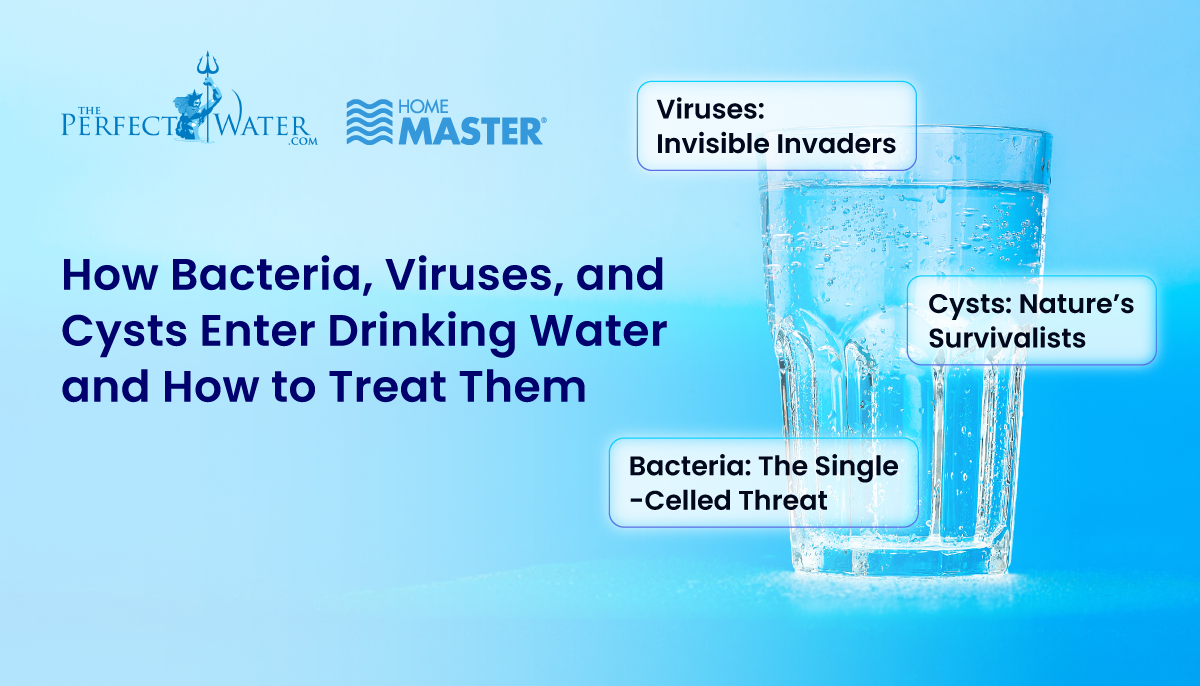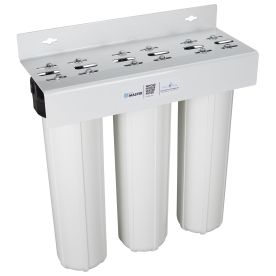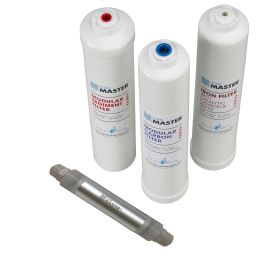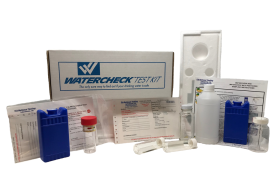
Clean, safe drinking water is essential for maintaining good health and well-being. Unfortunately, harmful microorganisms such as bacteria, viruses, and cysts can compromise water quality, leading to severe health risks. These contaminants often enter water supplies through various pathways, including environmental factors, inadequate sanitation, and infrastructure issues. Understanding how these microorganisms infiltrate drinking water, their associated health risks and the most effective treatment methods is crucial to protect yourself and your loved ones. This knowledge empowers you to make informed decisions about your water supply and ensures peace of mind with every sip.
Understanding Bacteria, Viruses, and Cysts
When discussing water contamination, it's essential first to understand the microscopic culprits that may infiltrate our water systems – bacteria, viruses, and cysts. These microorganisms pose varying levels of risk, and their presence underscores the importance of advanced water treatment technologies.
-
Bacteria: The Single-Celled Threat
Bacteria are tiny, single-celled organisms that are found everywhere, including water. While many bacteria are harmless and even beneficial, others, such as Escherichia coli (E. coli) and Salmonella, can be hazardous. These pathogens often enter water supplies through sewage contamination or agricultural runoff, leading to gastrointestinal illnesses, fevers, and, in severe cases, long-term health issues. For instance, exposure to E. coli can cause symptoms like stomach cramps, diarrhea, and vomiting, with severe strains potentially resulting in kidney failure (NIH). -
Viruses: Invisible Invaders
Viruses, much smaller than bacteria, are even more challenging to detect and combat. Common waterborne viruses like Hepatitis A and Norovirus are highly contagious, often spreading through human or animal waste that enters drinking water systems. Unlike bacteria, viruses rely on living hosts to multiply, making their presence in water particularly insidious. For example, Norovirus can survive in water for weeks, leading to outbreaks of gastroenteritis characterized by nausea, diarrhea, and dehydration. -
Cysts: Nature’s Survivalists
Cysts are the dormant and highly resilient forms of certain parasites, such as Giardia and Cryptosporidium. Encased in tough protective shells, these microorganisms are immune to conventional disinfection techniques like chlorine, making them particularly concerning in untreated or poorly treated water supplies. A common scenario is the contamination of water by animal feces, leading to cyst infiltration. When consumed, these parasites cause illnesses such as Giardiasis, marked by prolonged diarrhea, abdominal pain, and weight loss.
The presence of these pathogens in water systems isn’t just an abstract threat. It’s a tangible risk with significant health consequences. According to the World Health Organization (WHO), as of 2022, nearly 1.7 billion people worldwide consume water contaminated with feces, leading to diseases such as cholera, dysentery, and hepatitis. This alarming statistic highlights the critical need for effective water treatment systems capable of addressing these invisible dangers.
By understanding what bacteria, viruses, and cysts are, we can better appreciate the necessity of robust treatment options, such as UV water purification systems, RO systems, advanced filtration technologies, and chemical feed pumps. These systems not only safeguard your drinking water but also ensure peace of mind for your household.
Health Risks of Drinking Water Contaminated with Bacteria, Viruses, and Cysts
The consumption of water contaminated with bacteria, viruses, and cysts poses significant health risks, affecting people of all ages. These risks range from mild symptoms to life-threatening diseases, particularly for vulnerable populations like children, the elderly, and those with weakened immune systems.
-
Bacterial Infections
Bacteria such as E. coli and Salmonella are commonly found in contaminated water. E. coli, often introduced through agricultural runoff or sewage leakage, can lead to severe diarrhea, abdominal cramps, and dehydration. Meanwhile, Salmonella is known for causing typhoid fever, a condition marked by prolonged fever, weakness, and gastrointestinal distress. In the United States, the CDC reports about 1.35 million Salmonella infections annually, many of which are linked to unsafe water or food sources. -
Viral Infections
Viruses in drinking water, such as Hepatitis A and Rotavirus, can have serious consequences. Hepatitis A targets the liver, causing symptoms like jaundice, fatigue, and nausea. In extreme cases, it can lead to acute liver failure. On the other hand, Rotavirus is a major cause of severe diarrhea, especially in children under five. According to the WHO, diarrheal diseases are one of the leading causes of death in children globally, often linked to unsafe water. -
Parasitic Diseases
Microscopic parasites like Giardia and Cryptosporidium are particularly resilient, as their cyst forms can survive in chlorinated water. These organisms invade the gastrointestinal tract, leading to chronic diarrhea, abdominal pain, and dehydration. In some cases, infections can persist for weeks, further weakening an individual’s health. The EPA highlights these pathogens as a primary concern in water safety standards. -
The Global Impact
Every year, millions of people worldwide fall ill due to waterborne diseases, with developing nations bearing the brunt of the impact. However, developed countries like the U.S. are not immune to outbreaks, often caused by aging water infrastructure or natural disasters that compromise water supplies. This underscores the urgent need for reliable water purification systems in both urban and rural settings.
Water Treatment Methods for Bacteria, Viruses, and Cysts
Ensuring safe drinking water requires advanced treatment methods that effectively eliminate harmful microorganisms. Here’s how modern systems can safeguard your water supply:
-
UV Water Purification System
Ultraviolet (UV) purification is a cutting-edge technology that uses high-energy UV light to deactivate bacteria, viruses, and cysts. By disrupting their DNA, UV systems neutralize pathogens without the need for chemicals, making it an eco-friendly option. However, pre-filtration is crucial, as sediments or particles in the water can block UV rays, reducing effectiveness. UV water purification systems can destroy up to 99.99% of microorganisms, providing a robust defense against contaminants. -
RO System (Reverse Osmosis)
A reverse osmosis (RO) system employs a semi-permeable membrane to remove a broad spectrum of impurities, including harmful microorganisms when paired with a UV sterilizer. RO membranes, when new, will exclude bacteria, viruses, and cysts, but degrade and allow breakthrough as they age especially is not maintained. RO membranes are particularly effective when paired with sediment and carbon filters, which enhance pre-filtration and prolong the system’s lifespan. For households aiming for comprehensive purification, an RO system with UV is a reliable choice. -
Whole House Water Filters
For homes seeking full-spectrum protection, whole house water filters treat water at the point of entry, ensuring that every tap delivers clean and safe water. These systems often incorporate multiple filtration stages, including catalytic carbon filters, which are highly effective at removing chlorine-resistant pathogens like Cryptosporidium. Whole house filters are ideal for families, as they provide peace of mind across all water usage points, from drinking to showering. -
3-Stage Water Filter System
A 3 stage water filter system combines various filtration techniques to tackle multiple contaminants. Typically, the first stage removes sediments, the second employs advanced nanofiber filtration to eliminate microorganisms, and the third targets chemical impurities and soluble heavy metals with a combination of catalytic carbon and KDF85 redox media. This layered approach ensures thorough purification, making it a versatile option for addressing both microbial and chemical water quality issues. -
Chlorination and Boiling
Traditional methods like chlorination and boiling are effective to a certain extent. Chlorination introduces chemicals with a chemical feed pump to kill bacteria and viruses, but it is less effective against resilient cysts like Giardia. Boiling, while simple and accessible, can be impractical for large quantities of water and offers no residual protection. While these methods are valuable in emergencies, they are not substitutes for modern filtration systems in ensuring long-term water safety.
Conclusion
Clean water is not a luxury. It’s a necessity. Understanding how bacteria, viruses, and cysts enter drinking water and the risks they pose underscores the importance of reliable water treatment methods. Whether you choose a UV water purification system, an RO system, or a whole house water filter, investing in the right solution is essential for ensuring your family’s health and well-being.
By combining advanced filtration technologies and informed practices, you can protect your water supply and enjoy peace of mind with every sip.





